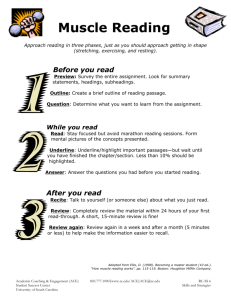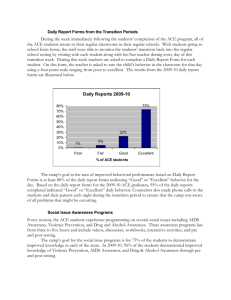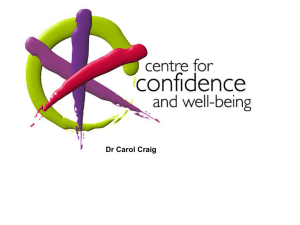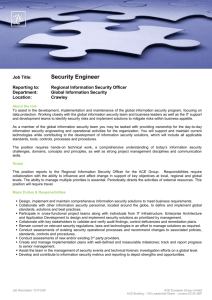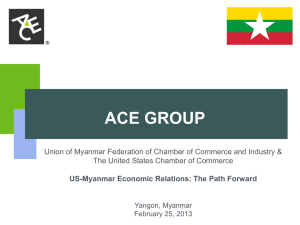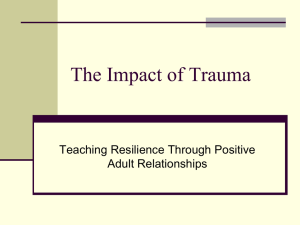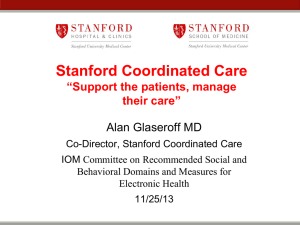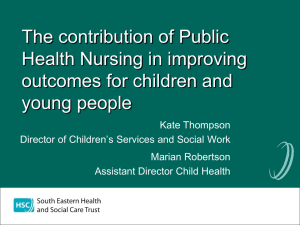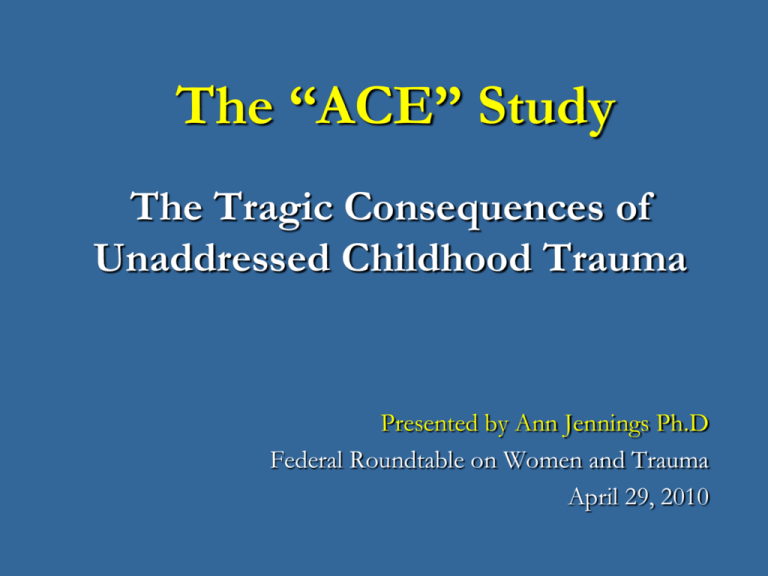
The “ACE” Study
The Tragic Consequences of
Unaddressed Childhood Trauma
Presented by Ann Jennings Ph.D
Federal Roundtable on Women and Trauma
April 29, 2010
Anna’s Story
This is Anna at age one
and a half
This is Anna years
later – in a mental
institution
What happened?
Anna
Caroline
Jennings
1960 - 1992
The Adverse Childhood
Experiences Study
(ACE Study)
“In my beginning is my end.”
T.S. Eliot, Four Quartets
What is the Adverse
Childhood
Experiences (ACE)
Study?
CDC and Kaiser Permanente Collaboration
Over decade long. 17,000 people involved.
Looked at effects of adverse childhood experiences
over the lifespan.
Largest study ever done on this subject.
ACE Study Findings
Childhood experiences are powerful
determinants of who we become as adults
Adverse Childhood Experience*
ACE Categories (Birth to 18)
Abuse of Child
Emotional abuse
Physical abuse
Contact Sexual abuse
Trauma in Child’s Household
Environment
Alcohol and/or Drug User
Chronically depressed, emotionally
disturbed or suicidal household
member
Mother treated violently
Imprisoned household member
Not raised by both biological
parents
(Loss of parent – best by death
unless suicide, - Worst by
abandonment)
Neglect of Child
Physical neglect
Emotional neglect
Impact of Trauma and Health
Risk Behaviors to Ease the Pain
Neurobiologic Effects of Trauma
Health Risk Behaviors
* Above types of ACEs are the “heavy
end” of abuse. *1 type = ACE score of 1
Disrupted neuro-development
Difficulty controlling anger-rage
Hallucinations
Depression - other MH Disorders
Panic reactions
Anxiety
Multiple (6+) somatic problems
Sleep problems
Impaired memory
Flashbacks
Dissociation
Smoking
Severe obesity
Physical inactivity
Suicide attempts
Alcoholism
Drug abuse
50+ sex partners
Repetition of original trauma
Self Injury
Eating disorders
Perpetrate interpersonal violence
Long-Term Consequences of
Unaddressed Trauma (ACEs)
Disease and Disability
Ischemic heart disease
Cancer
Chronic lung disease
Chronic emphysema
Asthma
Liver disease
Skeletal fractures
Poor self rated health
Sexually transmitted disease
HIV/AIDS
Serious Social Problems
Homelessness
Prostitution
Delinquency, violence, criminal
Inability to sustain employment
Re-victimization: rape, DV, bullying
Compromised ability to parent
Negative alterations in self perceptions and relationships with others
Altered systems of meaning
Intergenerational trauma
Long-term use of multiple human
service systems
HMO Members in ACE Study
80% White, including
Hispanic
About 50% men, 50%
women
10% Black
10% Asian
74% had attended
college
62% age 50 or older
Adverse Childhood Experiences
are Common
Of the 17,000 HMO Members:
1 in 4 exposed to 2 categories of ACEs
1 in 16 was exposed to 4 categories.
22% were sexually abused as children.
66% of the women experienced abuse,
violence or family strife in childhood.
Women were 50% more likely than men
to have experienced 5 or more ACEs
The higher the ACE Score, the
greater the likelihood of :
Severe and persistent emotional problems
Health risk behaviors
Serious social problems
Adult disease and disability
High health, behavioral health, correctional and
social service costs
Poor life expectancy
For example:
Emotional Problems
% With a Lifetime History of
Depression
Childhood Experiences
Underlie
Chronic Depression
80
70
60
50
40
30
20
Women
Men
10
0
0
1
2
ACE Score
3
>=4
Childhood Experiences
Underlie Suicide
25
4+
% Attempting Suicide
20
15
3
10
2
5
0
1
0
ACE Score
2/3rd (67%) of all suicide attempts
64% of adult suicide attempts
80% of child/adolescent suicide attempts
Are Attributable to
Childhood Adverse Experiences
Women are 3 times as likely as men
to attempt suicide over the lifespan.
Childhood sexual abuse is strongest most
independent risk factor for suicidality
As many as 42% of girls are
sexually abused before age 18
79.8% of American Indian
Alaskan Native (AIAN) girls
experience sexual abuse in
early childhood.
Young AIAN women are over 3
½ times more likely to commit
suicide than females in the
general population
Childhood Experiences Underlie Serious
and Persistent Mental Health Problems
Are We Misdiagnosing?
ACE Score and Hallucinations
Ever Hallucinated* (%)
12
10
Abused
Alcohol
or Drugs
8
No
Yes
6
4
2
0
0
1
2
3
4
5
6
ACE Score
*Adjusted for age, sex, race, and education.
>=7
Health Risk Behaviors
Adverse Childhood Experiences
and Current Smoking
20
18
16
14
12
%
10
8
6
4
2
0
0
1
2
3
ACE Score
4-5
6 or more
Childhood Experiences and
Adult Alcoholism
18
16
4+
% Alcoholic
14
12
3
10
2
8
6
1
4
2
0
0
ACE Score
ACE Score and Intravenous
Drug Use
% Have Injected Drugs
3.5
3
2.5
2
1.5
1
0.5
0
0
1
2
3
4 or more
ACE Score
N = 8,022
p<0.001
Adverse Childhood Experiences and
Likelihood of > 50 Sexual Partners
Adjusted Odds Ratio
4
3
2
1
0
0
1
2
ACE Score
3
4 or more
Serious Social Problems
Childhood Experiences Underlie
Rape
35
4+
% Reporting Rape
30
25
20
3
2
15
10
5
1
0
0
ACE Score
% have Unintended PG, or AB
ACE Score and Unintended
Pregnancy or Elective Abortion
80
Unintended Pregnancy
70
Elective Abortion
60
50
40
30
20
10
0
0
1
2
ACE Score
3
4 or more
ACE Score and Indicators of
Impaired Worker Performance
25
Prevalence of Impaired
Performance (%)
ACE Score
20
0
1
2
3
4 or more
15
10
5
0
Absenteeism (>2
days/month
Serious Financial
Poblems
Serious Job
Problems
Adult Disease and Disability
Higher ACE Score = significant rise in
chronic health conditions:
Sexually Transmitted Disease
Liver Disease
COPD
Ischemic Heart Disease
Autoimmune Disease
Lung Cancer
Poor Life Expectancy
Effect of ACEs on Mortality
Age Group
Percent in Age Group
60
19-34
35-49
50-64
>=65
50
40
30
20
10
0
0
2
4
ACE Score
0 ACE 60% live to 65
4 ACE less than 3% live to 65
The Many Faces of Women and Trauma
The Costs Are High
1992 Analysis of Cost of Anna’s Care
Over 17 years, Anna was hospitalized a total of 4,124
days. At $648 a day the cost was $2,639,360.
Other costs – entitlements, residential treatment, case
management, legal, medical – were estimated to be
over $1,000,000, bringing total cost to nearly
$4,000,000.
Adjusted for inflation (2005) total cost = $5,417,032
1992 Analysis of Cost of Anna’s Care
Intensive trauma based psychotherapy, figured at $150
a session, 2 sessions a week, for 17 years, would have
cost a total of $265,200 - (compared to $2,639,360)
Had trauma been recognized and treated at age 3,
costs would have been significantly less.
If parents had been trauma-informed, the abuse
may not have occurred.
The financial burden to society of childhood
abuse and trauma is staggering.
Annual Direct Costs: Hospitalization, Mental Health
Care System, Child Welfare Service System and Law
Enforcement = $33,101,302,133.00
Annual Indirect Costs: Special Education, Juvenile
Delinquency, Mental Health and Health Care, Adult
Criminal Justice System, Lost productivity to Society =
$70,652,715,359.00
Total Annual Cost: $103,754,017,492.00 (Over
$184 million dollars a day)
Economic Impact Study. (September, 2007). Prevent Child Abuse America
“The solution of adult problems
tomorrow depends in large measure
upon the way our children grow up
today.
Margaret Mead
Thank You
www.TheAnnaInstitute.Org
Handouts
Chart of Adverse Childhood Experiences Study
Finding Your ACE Score: A Questionnaire
ACE Publications on Major findings by Health
Outcomes
“The Hidden Epidemic: The Impact of Early
Life Trauma on Health and Disease”
Sources
ACE Publications: For comprehensive list see CDC ACE
Study website: Publications on Major Findings By Health
Outcomes: This site was updated (March 1, 2010) and links to
related articles on all subjects.
http://www.cdc.gov/nccdphp/ACE/outcomes.htm
The Damaging Consequences of Violence and Trauma:
See Trauma-Informed Resources :
www.TheAnnaInstitute.Org
Documents and articles on women and trauma:
Presentation Bibliography in preparation. Available upon
request: Ann Jennings,
afj@gwi.net
ACE Study slides are from:
Robert F. Anda MD at the Center for Disease Control and
Prevention (CDC)
September 2003 Presentation by Vincent Felitti MD
“Snowbird Conference” of the Child Trauma Treatment Network
of the Intermountain West
“The Relationship of Adverse Childhood Experiences to
Adult Medical Disease, Psychiatric Disorders, and Sexual
Behavior: Implications for Healthcare” Book Chapter for
“The Hidden Epidemic: The Impact of Early Life Trauma on Health
and Disease” Lanius & Vermetten, Ed)
Presentation Artwork
All artwork in this presentation was created by Anna
Caroline Jennings. Although she had no formal
training, her work is stark, sophisticated and haunting.
It has been exhibited at conferences across the country.
Through her paintings and drawings she vividly and
poignantly expresses her abuse at the hands of
perpetrators and within the mental health system.
Her work and story are displayed on the website:
www.TheAnnaInstitute.org.
Trauma Informed Resources
http://mentalhealth.samhsa.gov/nctic/default.asp
SAMHSA National Center for Trauma-Informed Care
www.TheAnnaInstitute.org:
The Anna Institute Inc:
ACE Study Section: Powerpoint presentation slides and
notes; 41 full downloadable ACE Study articles; related
materials; collection of ACE Study powerpoint slides
Annotated list of Trauma Websites
Models for Developing Trauma-Informed Behavioral Health
Systems and Trauma-Specific Services, 2008
Downloadable trauma-informed articles, powerpoints,
educational materials; links; Anna’s story and art exhibit.

